There is much talk across higher education about enhancing “classroom engagement”, particularly as in-person attendance continues to dwindle post-pandemic. We know that we cannot return to pre-pandemic methods of engaging our students, because expectations have changed. Yet the way in which we view and discuss “classroom engagement” has not progressed in the ways it should.
Unpacking the term is useful in reimagining our provision in more dynamic and contemporary ways. First, we should no longer perceive the four walls of the physical classroom as the pivotal space through which engagement takes place. Instead, we need to see this as one component among several learning spaces and opportunities that we create to effectively deliver higher education.
Second, we should reconceptualise the notion of engaging students, as it can be slightly misleading, with a tendency to place pressure on the teacher’s ability to effectively perform and deliver content in compelling and entertaining ways. Instead, we propose seeing engagement as an outcome of successful student-centred learning strategies. Engagement in this sense applies to the ways in which students interact with materials and resources; their peers; the teacher; the activities that are presented to them; the online and face-to-face learning environments; and the content that is covered.
- Resource collection: Pedagogies to reinvigorate your teaching
- Resource collection: Enhance student engagement
- What does ‘student engagement’ mean to you? And you? And you?
Achieving classroom engagement through student-centred learning
We can incorporate a diverse range of student-centred learning strategies in order to engage students holistically across all the learning spaces and opportunities we provide.
Here are five learner-focused ideas that can be quickly embedded into any educational environment:
1. Active learning
A sure-fire method of improving engagement is by integrating activities that encourage doing. This means that students are creating, discussing, building, investigating, producing and critically thinking in ways that evidence their learning and application of course content. Examples of this include role-playing, presenting ideas, engaging in debates and creating artefacts. Such active learning strategies are possible regardless of where your physical classroom is, or how many students are in your course. If we extend the notion of what the classroom means, digital tools can facilitate autonomous and peer learning through student-centred, active learning strategies. For example, we can encourage students to contribute to an online community glossary hosted on a learning platform, supporting each other in better understanding and revising content. Again, groups of students can collaborate remotely to develop activities and role-play scenarios for the whole class, participating in the delivery of the module.
2. Value student input to course content
Students become interested and engaged when they can meaningfully contribute to the learning environment. Our role then as teachers is to consistently demonstrate an openness to the idea that our students are co-producers of knowledge; to show curiosity and willingness to learn from them; and to give students a chance to own course content that enhances the learning experience of the entire class. Taking this approach opens the diversity of discussion and activity, allows students to shape their own learning, and, ideally, develops belonging within the class. This might include giving students opportunities to teach a session of the module or to decide upon discussion topics and homework tasks, creating a flexible learning culture whereby the classroom can change based on student input and interest.
3. Incorporate agency and ownership in assessment
Students are very assessment-focused and our current educational culture places assessment as a high-stakes component of learning. Taking this into account, assessment is often packaged in fear – which impacts engagement. When we place students, their learning, well-being and future aspirations, at the heart of our assessment programmes, we can create a very positive learning experience. The key is to embed agency and ownership in assessment so students can apply what they have learned in ways they feel would be beneficial to them. This could mean designing assessment activities that link to opportunities of interest beyond our modules such as students presenting research at a conference or enabling students to choose the topic and format of their assignment and select a deadline.
4. Co-create resources
Students engage with course information and resources better when they are accessible and learner focused. While our course documentation, such as assignment briefs and marking schemes, are traditionally peer-reviewed by academics, this moderation strategy sometimes places student-centredness as an oversight. We have found that co-creating module guidance, assignment briefs and marking criteria with students ensures our essential course documentation is student-friendly, approachable and motivational.
5. Integrate empathy, compassion and socio-emotional intelligence
Engagement happens when students feel valued, heard and understood. Developing and using our socio-emotional intelligence as teachers when implementing student-centred learning is essential for establishing healthy teacher-learner relationships, compassionate learning environments, and for challenging unhelpful hierarchies that negatively impact learning. To achieve this we should critically evaluate how we communicate with students, demonstrate care for student well-being and provide, where possible, tailored support.
The student-centred classroom
By conceptualising the classroom as a versatile space, where holistic experiences of student-centred learning can take place, we can reimagine and stretch opportunities for engagement. We want students to thrive and this comes from facilitating caring, flexible and learner-focused environments where each individual can contribute to the learning experience.
Heather Meyer is associate professor and director of studies and Elena Riva is associate professor (reader) and head of department, both at the Institute for Advanced Teaching and Learning (IATL), University of Warwick.
If you would like advice and insight from academics and university staff delivered direct to your inbox each week, sign up for the Campus newsletter.




comment